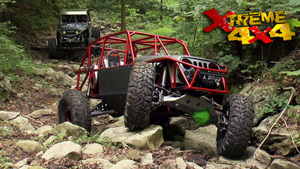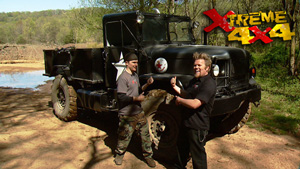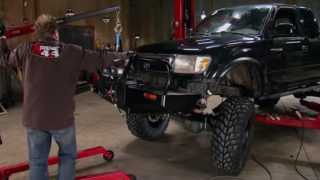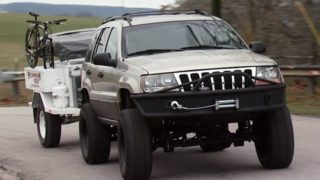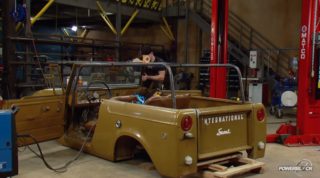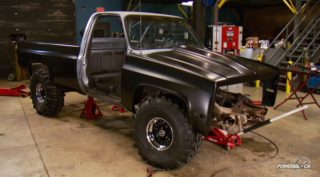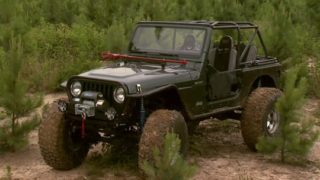More Military 6X6 Bobbed Deuce Episodes
Xtreme 4x4 Builds
Want more content like this?
Join the PowerNation Email NewsletterParts Used In This Episode
Accuair
eLevel Air Management Package
Ballistic Fabrication
Rockwell Axle Brackets
Ballistic Fabrication
Rod End Tubing Adapters
Ballistic Fabrication
Ultra Duty Ballistic Joints
Boyce Equipment
RF Fender
Boyce Equipment
Two Battery Tray with Step
Episode Transcript
We put our five ton soldier on a diet turning this six by six into 1 Xtreme 4x4 today on the show part two of our Bob's Deuce pickup truck will flip some hugs, install some bags and create link suspension to keep her roll and steady on the highway. Plus our fuel saving street truck returns for a crash diet of its own
today
on extreme, we're back to thinking big. No, I don't mean big budget or fancy parts or even a whole bunch of work. I mean just big in size. This is the biggest truck we've ever built. And you gotta say for the amount of money we have in this thing, it's about 3500 bucks. We definitely have a one of a kind four wheel drive truck and we brought it back in the shop today. We gotta start by taking care of a few odds and ends like fixing up this battery box. Then we're gonna jump on the rear suspension, throw some air ride on here so we can lay this truck out to make it easier to put the Suzuki in the bed. Then we're going for a drive.
We started with a retired military fire truck that we picked up from voice equipment and had delivered to the extreme shop
after a little test drive
and some showing off the new toy down at the local fire station.
We had one job for this truck before we started to cut it up.
Once the firebox
pump and controls will remove,
we ditched the extra axle, shorten the frame
and built a truck bed that had similar styles to a military trailer
but was big enough to carry our Suzuki Samurai.
Then finally, we added the cream of the crop set of 50 inch Michelins and 20 inch steel wheels to complete our Bob
Deuce.
Now, the battery box for this truck is integrated right underneath the door. Now, the original one, obviously, it's seen better days and we kind of helped along the way by driving over that car. Now, this box was originally set up to hold four batteries because two of the batteries ran part of the fire box in the back. We don't need that.
These old military trucks, they are a 24 volt system. So they do carry 212 volt batteries that you wire up in series. Now, to fix this, we had voice equipment, send us a used battery tray. Now this will simply replace our 41
with a two battery step and then on the outside
place to get in.
Oh,
another area of our deuce that had some damage was the right front fender,
just like our step Boyce sent us a new one to replace it.
Yeah, it's the wrong color,
but we'll go ahead and give it a coat of paint along with the rest of the truck a little later on.
I think it looks good like this. It's like a Jeep.
Now, we're not just going to be repairing damage today. We're also going to be changing some things to make the truck a little bit safer when it's off road and running down the highway. And the first thing we're going to do is take care of these air tanks. Now, these air tanks house compressed air that's produced by an engine driven compressor that's up underneath the hood. Now, that compressed air is used for three things. One used for the air horn, which is pretty cool and two, it's used to operate the air powered transfer case lock, but more importantly, it's used to
the brakes. Now, the military rig does not have traditional air brakes like a big rig where the brakes are on and the compressed air turns them off. It uses the compressed air as an assist. So the compressor that's in these tanks helps you push down that brake pedal. If you lose any of the air inside this tank, the brakes get very stiff and it's hard to stop a truck this big. So what we're gonna do is flip the brackets over, get the tanks up closer to the bed floor so they're out of the way away from trail obstacles.
Yeah,
we,
you may have noticed that our rear tires are further in than our front.
This is because the dual rear wheels on the rock well in the back have a narrower track width, but the Rockwell hubs can be flipped, making the track wid match both front and rear.
Like
what
now? Although the difference may seem minor, it makes a big change on the back of this truck. You can see we've moved this rear tire out about five inches further from this frame rail, unlike the un flipped hub where the tire is tucked up inside doesn't really suit the scale of the truck. It looks a little weird on the back with this bed on here. Now, all we have to do is go ahead and flip the hub on this side to match. We'll lift the bed off, start working on some suspension
later on massive rod ends, anchor a custom four lane when Xtreme 4x4 continues
extreme. We're knocking out a bunch of things on our six by six, which is now a great big four by four. It fix some of the damage and now we can start throwing some new parts of this truck. First thing we're going to deal with is the rear suspension and for that, we're going to be running this truck on airbags. Now, these are heavy duty industrial series airbags designed to handle the weight of our six by six. Now, we're just going to run two of these in the back and that's not only going to give us a better ride, but it's also going to give us full adjustment,
the ability of that rear suspension. Thanks to a complete air delivery system that we got from ACU
air. Now, this has a set of solenoids that will deliver air to the bags and all the electronics that are needed and even twin V
air compressors that not only deliver enough air to run our suspension, but we can also run air tools. But the unique feature here is the three mode setup. We can set up our bags with three different memory modes. We can have just a simple ride height mode where it fills the bags with specific amount of air for driving down the road. When we load the truck with the
Zook, we can add more air to the bags and it'll remember that ride height and then we can even dump all the air out with just a flick of one switch to do what's called lower to load feature. Now, what that does, it's going to drop the back end of the truck down. Now, if you have a truck in the back running on bags, that's a great feature right there. Even if it's just lifted up, you need to throw some cement in the back at the home center, it's gonna drop that back end down 68 inches, make it a lot
easier to load. Now, it does all of that with this little sensor right here. It'll mount up on the frame rail. This rod will ride on the control arm that will tell the computer what height the suspension is at and give it a little bit more accurate determination of how much air to put in the bags instead of just using air pressure. Because in a truck this big, you can't just rely on air pressure. You need that actual input from the computer. Now, we're gonna be using our lower to load feature in a very specific way.
Now, the plan from the very beginning was to build a beefy tailgate right around 3 ft long. We need it that long because when it's lowered in the down position, the rear wheel of the Zook is probably going to sit right about here. The wheel base of our truck is just a little bit longer than the 9 ft that we made. This bet we're going to use the lower to load feature and that long tailgate to our advantage, we're going to mount the air in between the Rockwell axle and the frame and when we dump the air out of them, it's going to drop down about 12 inches. That's going to move the backs set of this frame rails down about 15 to 16 inches because it's so far away from that pivot point Now, once we get it lower down and mocked into place, we'll measure how long we need to make our tailgate. That way. When we dump the bags, we'll drop the tailgate down.
It'll lower the whole truck down and we'll probably end up with maybe a little ramp about 12 inches off the ground. The zoo will be easy just to drive right up on the back of the tailgate into the back of the truck, fill up the bags, let it sit, strap it down and we'll be ready to go. No ramps need it before we build anything. First thing we have to do is get the bed off, take out all that mock up suspension.
Trust me, hanging
me
with the temporary bracing removed from the axle. We'll check the location to be sure that it's still square under the truck.
The bag mouth will be made from quarter inch plates
and the airbags sandwiched between the frame rail and the rockwell axle tube.
The tank along with the two compressors are mounted to the frame rail of the truck
and the ECU and solenoid valves are secured to the back of the cab
and then hooked up to our air tank.
And finally all the electrical connectors can be plugged in
for temporary power. We're going to use a battery charger to energize the system.
I didn't write that.
I don't know why
I don't have voltage.
See folks, he really doesn't know everything sometimes he has to read up.
Look at all these things you gotta do here.
This is crazy.
I'm gonna make it go up now.
I will make it go down.
Well, we can operate our system in manual mode only right now to take advantage of those preset ride heights we talked about earlier. We need to mount these sensors off the frame and off the four length bars which we haven't built yet. That's coming up next.
The airbags we put in the back of our truck are just part of our rear suspension puzzle. We need to build a link type suspension to locate the rear axle and also allow it to travel through that entire range of movement we have with our air bags underneath the truck. Now to do that, we're going to be using a pile of these CNC bent and laser cut brackets that we got from ballistic fabrication. Now, some of these are universal brackets like this frame side one and we also have some Rockwell specific brackets. Now we're also going to be using
the new ballistic fabrication monster rod ends. These are specifically designed for heavy abuse situations and large loads like a rockwell axle in the back of a big truck. They are fully rebuildable by removing this ring and then replacing the
Dlin bushings that are inside on either side of the chrome Molly Ball that has the integrated misalignment spacers. All we have to do right now is basically set these in place on the brackets and tabs build some link bars.
The Rockwell specific center bracket indexes off the side bearing support and the upper inspection coverage,
the upper mounts are then tacked in place on the inside of the frame.
The
tubing is sleeve for strength giving us a total of a quarter inch wall thickness.
And the tubing adapters are tacked into place
similar to the uppers. The lowers will travel from the outside of the axle up to the frame rail
and then the link bars are installed.
Now, by designing this four link with two opposing vs, the upper is traveling from the center of the axle out to the frame and the lower is traveling from the outer side in, it'll locate the rear axle. We don't need a pan hard bar, it'll just keep it nice and tight on the back of the truck. We do need to install one more thing and that is a set of shock absorbers. The air bags on the back of this axle are just like a set of springs in the back of a regular truck. If you don't have a shock absorber on there, when you're driving down the road, the back,
you can pick up a little bit of harmonic and you start to bounce all the way down the highway shock absorber keeps that from happening. We need a set of custom shock absorbers for this truck and we need to measure for it. First measurement we have to take is with the bags completely deflated, will come from the axle up to the frame rail and come in about 12 inches. Then we'll go ahead and inflate the bags from this little valve. I've hooked up to the air compressor to the maximum height of the suspension is gonna sit at, we'll take
that exact same measurement
and it comes up
about eight inches of travel. So what we need is a shock that has an eight inch stroke. That way it won't bind the bags when they're traveling up and down from the rear suspension. Now, all we have to do is go ahead, finish weld all these four
length parts and these bag mounts. We'll go ahead and reinstall the air compressor as well as the air tank. Maybe give the back of this a little coat of paint. We'll drop the bed back on this truck. Keep working.
You're watching Xtreme 4x4 for a DVD copy of this episode. Just go to Power Block tv.com and order your copy for just 595 plus shipping and handling. Start your own Xtreme 4x4 collection delivered right to your door from the power block.
We're back on Xtreme 4x4 with the suspension bagged and linked Ian and Chris are in the process of building a custom military style pickup bed.
So what we've been able to do today is take a very little bit of money, probably around 3500 to $4500 and build a 100% custom huge pickup truck. Now, building that custom bed on the back was definitely the right choice. It's a little bit cheaper and the scale fits it a little bit nicer than the trailer bed option that a lot of guys use on this truck. Plus nobody else is gonna have a bed like that on the back of their Bob Deuce. So, what we've done is we've basically taken a six by six,
turned it into a four by four
that's sitting on custom suspension on the rear. A four L
supported by air bags with a very unique lower to load feature. Go ahead and dump it out, Chris, what this will allow us to do is basically drop the back end of the truck. This will come in handy whether we're putting a bag
groceries in the back at the local store or driving the Zook into the back to head out to the trail and we're not done with this truck that some odds and ends to take care of. Obviously, it's about 18 different colors. So we need to take care of the paint, tighten up a few things, build the tailgate and then we'll go for a drive
now not too long ago, we pulled this dodge ram 1500 pickup into the shop to chase down some fuel economy myths. Remember we're trying to take a lifted street truck like this, get better fuel mileage when we're driving on the street and at the same time, make it a more capable off Roader. And our focus so far has been on getting that fuel economy number up from the eight
MPG that we started with. Last time we removed the mechanical fan off the front of the engine and replaced it with an electric fan to see if we,
that load would get us better mileage. And it has, we've picked up about 0.15
MPG and that means we can go about three extra miles on every tank full. Now, it's not a lot, but it is the first step. And today we're going to focus on something that anyone could do. It applies to almost every vehicle out there. We carry stuff in our cars and our trucks that we don't need to have in there. All that extra weight adds up every 100 pounds takes about 2% off your fuel mileage. So we're going to go ahead and put this truck on a diet.
We'll start with everything on the inside
man. Whoever owns this truck is a slob.
Actually, it's, it's my truck.
I'm a sloth
79 pounds
of junk.
So our truck just lost 342 pounds. Now, all we have to do is run a few more tanks of fuel through it and come up with a new fuel mileage number.
Show Full Transcript
today
on extreme, we're back to thinking big. No, I don't mean big budget or fancy parts or even a whole bunch of work. I mean just big in size. This is the biggest truck we've ever built. And you gotta say for the amount of money we have in this thing, it's about 3500 bucks. We definitely have a one of a kind four wheel drive truck and we brought it back in the shop today. We gotta start by taking care of a few odds and ends like fixing up this battery box. Then we're gonna jump on the rear suspension, throw some air ride on here so we can lay this truck out to make it easier to put the Suzuki in the bed. Then we're going for a drive.
We started with a retired military fire truck that we picked up from voice equipment and had delivered to the extreme shop
after a little test drive
and some showing off the new toy down at the local fire station.
We had one job for this truck before we started to cut it up.
Once the firebox
pump and controls will remove,
we ditched the extra axle, shorten the frame
and built a truck bed that had similar styles to a military trailer
but was big enough to carry our Suzuki Samurai.
Then finally, we added the cream of the crop set of 50 inch Michelins and 20 inch steel wheels to complete our Bob
Deuce.
Now, the battery box for this truck is integrated right underneath the door. Now, the original one, obviously, it's seen better days and we kind of helped along the way by driving over that car. Now, this box was originally set up to hold four batteries because two of the batteries ran part of the fire box in the back. We don't need that.
These old military trucks, they are a 24 volt system. So they do carry 212 volt batteries that you wire up in series. Now, to fix this, we had voice equipment, send us a used battery tray. Now this will simply replace our 41
with a two battery step and then on the outside
place to get in.
Oh,
another area of our deuce that had some damage was the right front fender,
just like our step Boyce sent us a new one to replace it.
Yeah, it's the wrong color,
but we'll go ahead and give it a coat of paint along with the rest of the truck a little later on.
I think it looks good like this. It's like a Jeep.
Now, we're not just going to be repairing damage today. We're also going to be changing some things to make the truck a little bit safer when it's off road and running down the highway. And the first thing we're going to do is take care of these air tanks. Now, these air tanks house compressed air that's produced by an engine driven compressor that's up underneath the hood. Now, that compressed air is used for three things. One used for the air horn, which is pretty cool and two, it's used to operate the air powered transfer case lock, but more importantly, it's used to
the brakes. Now, the military rig does not have traditional air brakes like a big rig where the brakes are on and the compressed air turns them off. It uses the compressed air as an assist. So the compressor that's in these tanks helps you push down that brake pedal. If you lose any of the air inside this tank, the brakes get very stiff and it's hard to stop a truck this big. So what we're gonna do is flip the brackets over, get the tanks up closer to the bed floor so they're out of the way away from trail obstacles.
Yeah,
we,
you may have noticed that our rear tires are further in than our front.
This is because the dual rear wheels on the rock well in the back have a narrower track width, but the Rockwell hubs can be flipped, making the track wid match both front and rear.
Like
what
now? Although the difference may seem minor, it makes a big change on the back of this truck. You can see we've moved this rear tire out about five inches further from this frame rail, unlike the un flipped hub where the tire is tucked up inside doesn't really suit the scale of the truck. It looks a little weird on the back with this bed on here. Now, all we have to do is go ahead and flip the hub on this side to match. We'll lift the bed off, start working on some suspension
later on massive rod ends, anchor a custom four lane when Xtreme 4x4 continues
extreme. We're knocking out a bunch of things on our six by six, which is now a great big four by four. It fix some of the damage and now we can start throwing some new parts of this truck. First thing we're going to deal with is the rear suspension and for that, we're going to be running this truck on airbags. Now, these are heavy duty industrial series airbags designed to handle the weight of our six by six. Now, we're just going to run two of these in the back and that's not only going to give us a better ride, but it's also going to give us full adjustment,
the ability of that rear suspension. Thanks to a complete air delivery system that we got from ACU
air. Now, this has a set of solenoids that will deliver air to the bags and all the electronics that are needed and even twin V
air compressors that not only deliver enough air to run our suspension, but we can also run air tools. But the unique feature here is the three mode setup. We can set up our bags with three different memory modes. We can have just a simple ride height mode where it fills the bags with specific amount of air for driving down the road. When we load the truck with the
Zook, we can add more air to the bags and it'll remember that ride height and then we can even dump all the air out with just a flick of one switch to do what's called lower to load feature. Now, what that does, it's going to drop the back end of the truck down. Now, if you have a truck in the back running on bags, that's a great feature right there. Even if it's just lifted up, you need to throw some cement in the back at the home center, it's gonna drop that back end down 68 inches, make it a lot
easier to load. Now, it does all of that with this little sensor right here. It'll mount up on the frame rail. This rod will ride on the control arm that will tell the computer what height the suspension is at and give it a little bit more accurate determination of how much air to put in the bags instead of just using air pressure. Because in a truck this big, you can't just rely on air pressure. You need that actual input from the computer. Now, we're gonna be using our lower to load feature in a very specific way.
Now, the plan from the very beginning was to build a beefy tailgate right around 3 ft long. We need it that long because when it's lowered in the down position, the rear wheel of the Zook is probably going to sit right about here. The wheel base of our truck is just a little bit longer than the 9 ft that we made. This bet we're going to use the lower to load feature and that long tailgate to our advantage, we're going to mount the air in between the Rockwell axle and the frame and when we dump the air out of them, it's going to drop down about 12 inches. That's going to move the backs set of this frame rails down about 15 to 16 inches because it's so far away from that pivot point Now, once we get it lower down and mocked into place, we'll measure how long we need to make our tailgate. That way. When we dump the bags, we'll drop the tailgate down.
It'll lower the whole truck down and we'll probably end up with maybe a little ramp about 12 inches off the ground. The zoo will be easy just to drive right up on the back of the tailgate into the back of the truck, fill up the bags, let it sit, strap it down and we'll be ready to go. No ramps need it before we build anything. First thing we have to do is get the bed off, take out all that mock up suspension.
Trust me, hanging
me
with the temporary bracing removed from the axle. We'll check the location to be sure that it's still square under the truck.
The bag mouth will be made from quarter inch plates
and the airbags sandwiched between the frame rail and the rockwell axle tube.
The tank along with the two compressors are mounted to the frame rail of the truck
and the ECU and solenoid valves are secured to the back of the cab
and then hooked up to our air tank.
And finally all the electrical connectors can be plugged in
for temporary power. We're going to use a battery charger to energize the system.
I didn't write that.
I don't know why
I don't have voltage.
See folks, he really doesn't know everything sometimes he has to read up.
Look at all these things you gotta do here.
This is crazy.
I'm gonna make it go up now.
I will make it go down.
Well, we can operate our system in manual mode only right now to take advantage of those preset ride heights we talked about earlier. We need to mount these sensors off the frame and off the four length bars which we haven't built yet. That's coming up next.
The airbags we put in the back of our truck are just part of our rear suspension puzzle. We need to build a link type suspension to locate the rear axle and also allow it to travel through that entire range of movement we have with our air bags underneath the truck. Now to do that, we're going to be using a pile of these CNC bent and laser cut brackets that we got from ballistic fabrication. Now, some of these are universal brackets like this frame side one and we also have some Rockwell specific brackets. Now we're also going to be using
the new ballistic fabrication monster rod ends. These are specifically designed for heavy abuse situations and large loads like a rockwell axle in the back of a big truck. They are fully rebuildable by removing this ring and then replacing the
Dlin bushings that are inside on either side of the chrome Molly Ball that has the integrated misalignment spacers. All we have to do right now is basically set these in place on the brackets and tabs build some link bars.
The Rockwell specific center bracket indexes off the side bearing support and the upper inspection coverage,
the upper mounts are then tacked in place on the inside of the frame.
The
tubing is sleeve for strength giving us a total of a quarter inch wall thickness.
And the tubing adapters are tacked into place
similar to the uppers. The lowers will travel from the outside of the axle up to the frame rail
and then the link bars are installed.
Now, by designing this four link with two opposing vs, the upper is traveling from the center of the axle out to the frame and the lower is traveling from the outer side in, it'll locate the rear axle. We don't need a pan hard bar, it'll just keep it nice and tight on the back of the truck. We do need to install one more thing and that is a set of shock absorbers. The air bags on the back of this axle are just like a set of springs in the back of a regular truck. If you don't have a shock absorber on there, when you're driving down the road, the back,
you can pick up a little bit of harmonic and you start to bounce all the way down the highway shock absorber keeps that from happening. We need a set of custom shock absorbers for this truck and we need to measure for it. First measurement we have to take is with the bags completely deflated, will come from the axle up to the frame rail and come in about 12 inches. Then we'll go ahead and inflate the bags from this little valve. I've hooked up to the air compressor to the maximum height of the suspension is gonna sit at, we'll take
that exact same measurement
and it comes up
about eight inches of travel. So what we need is a shock that has an eight inch stroke. That way it won't bind the bags when they're traveling up and down from the rear suspension. Now, all we have to do is go ahead, finish weld all these four
length parts and these bag mounts. We'll go ahead and reinstall the air compressor as well as the air tank. Maybe give the back of this a little coat of paint. We'll drop the bed back on this truck. Keep working.
You're watching Xtreme 4x4 for a DVD copy of this episode. Just go to Power Block tv.com and order your copy for just 595 plus shipping and handling. Start your own Xtreme 4x4 collection delivered right to your door from the power block.
We're back on Xtreme 4x4 with the suspension bagged and linked Ian and Chris are in the process of building a custom military style pickup bed.
So what we've been able to do today is take a very little bit of money, probably around 3500 to $4500 and build a 100% custom huge pickup truck. Now, building that custom bed on the back was definitely the right choice. It's a little bit cheaper and the scale fits it a little bit nicer than the trailer bed option that a lot of guys use on this truck. Plus nobody else is gonna have a bed like that on the back of their Bob Deuce. So, what we've done is we've basically taken a six by six,
turned it into a four by four
that's sitting on custom suspension on the rear. A four L
supported by air bags with a very unique lower to load feature. Go ahead and dump it out, Chris, what this will allow us to do is basically drop the back end of the truck. This will come in handy whether we're putting a bag
groceries in the back at the local store or driving the Zook into the back to head out to the trail and we're not done with this truck that some odds and ends to take care of. Obviously, it's about 18 different colors. So we need to take care of the paint, tighten up a few things, build the tailgate and then we'll go for a drive
now not too long ago, we pulled this dodge ram 1500 pickup into the shop to chase down some fuel economy myths. Remember we're trying to take a lifted street truck like this, get better fuel mileage when we're driving on the street and at the same time, make it a more capable off Roader. And our focus so far has been on getting that fuel economy number up from the eight
MPG that we started with. Last time we removed the mechanical fan off the front of the engine and replaced it with an electric fan to see if we,
that load would get us better mileage. And it has, we've picked up about 0.15
MPG and that means we can go about three extra miles on every tank full. Now, it's not a lot, but it is the first step. And today we're going to focus on something that anyone could do. It applies to almost every vehicle out there. We carry stuff in our cars and our trucks that we don't need to have in there. All that extra weight adds up every 100 pounds takes about 2% off your fuel mileage. So we're going to go ahead and put this truck on a diet.
We'll start with everything on the inside
man. Whoever owns this truck is a slob.
Actually, it's, it's my truck.
I'm a sloth
79 pounds
of junk.
So our truck just lost 342 pounds. Now, all we have to do is run a few more tanks of fuel through it and come up with a new fuel mileage number.







